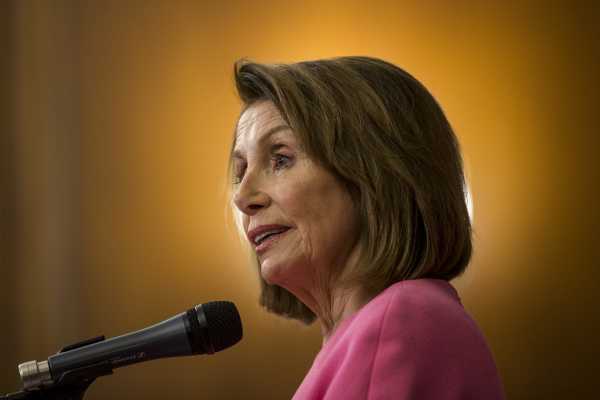
House Minority Leader Nancy Pelosi is making her case to be the next House speaker.
Fresh off a resounding Democratic win on Tuesday night, Pelosi sent out a letter to each member of the House Democratic caucus on Wednesday night laying out her argument. She has also begun calling members to ask for their votes.
“My vision for the next two years is to restore the House to the role it should have as a strong and independent voice for the American people, and maximize the ability and the creativity of our entire Caucus,” Pelosi wrote in her letter.
Pelosi needs 218 votes, but she has already passed a big test: the midterm elections. Despite structural disadvantages of gerrymandered congressional districts favoring Republicans, Democrats have so far clinched 226 seats in the House. There are 12 more undecided races to go, and at least four look like they will be Democratic victories. It’s a big enough margin of victory that Pelosi can lose a few Democrats and win.
But she has another test coming. A group of Pelosi detractors in the Democratic caucus is organizing to vote against her during the all-important January 3 floor vote to elect the next speaker. These younger and often more moderate members of the caucus have long been dissatisfied with the entrenched leadership at the top. They have been privately reaching out to a small number of Democratic candidates who have publicly committed not to vote for her, a number they’re hoping to grow.
Pelosi’s office is still projecting confidence she will win.
“Leader Pelosi is confident in her support among Members and Members-elect,” said spokesperson Drew Hammill in a statement. “Democrats don’t let Republicans choose their leaders. The election proved that the GOP attacks on Pelosi simply do not work.”
Still, no direct Pelosi challengers have yet emerged, and the Democratic leader and her allies feel confident that the margin of Democratic seats will give her enough wiggle room to win.
“She’s got plenty of room to maneuver,” said a senior Democratic aide. “She also has no opponent, and the rebels are fumbling all over the place in disagreement over strategy.”
The anti-Pelosi movement is getting organized
The margin by which Democrats won had consequences for Pelosi’s chances as speaker. A number of incoming Democrats who won their races on Tuesday night have publicly confirmed they won’t support her bid for speaker, including Jason Crow of Colorado, Abigail Spanberger of Virginia, and Conor Lamb of Pennsylvania (Lamb won a special election in March but just won his first full term). But Pelosi’s allies believe it won’t be enough to actually jeopardize her position.
“Lots of the ardent naysayers lost. That’s the most important point,” said the senior Democratic aide. “Most of the folks who ran Pelosi ads lost.”
A group of Democratic incumbents and newly elected Democrats are banding together, committing to vote against Pelosi during the floor vote. So far, Reps. Ed Perlmutter (D-CO), Kathleen Rice (D-NY), Seth Moulton (D-MA), Bill Foster (D-IL), Tim Ryan (D-OH), Filemon Vela (D-TX), and Kurt Schrader (D-OR) have committed to vote no, as well as Lamb, Crow, and Spanberger. That’s a total of 10, which could put Pelosi in uncertain territory with her math, depending how many more outstanding districts Democrats win.
If the number That group is hoping to grow their ranks in the coming weeks, as new members arrive for orientation next week.
“These members recognize they need to be a support system for incoming freshman who said they would be no on the floor to make sure they know they’re not alone,” one Democratic aide told Vox.
The aide described new members who committed to vote against Pelosi as being in a tough position; either having to go back on their promise in their very first vote as new members, or voting outright against a powerful leadership slate that’s been leading Democrats since 2006.
“That’s an awful place to be if you’re an incoming freshman and it’s leadership putting them in this position,” the aide said. “Leadership is going to try to twist arms and promise people things.”
Roll Call’s Lindsey McPherson has a good breakdown of what each newly elected Democrat has said so far about the all-important public January 3 floor vote for speaker of the House. Besides Crow, Spanberger, and Lamb, eight more have publicly opposed Pelosi on the campaign trail, but haven’t yet committed to voting no.
“We’re going to have some conversations in the next 24 to 48 hours with all these majority makers and see what they need,” Rep. Ryan told Vox on election night. “They’re ones that got elected in some of these tough districts. We need to be very mindful of what they need the leadership team to look like and what they need the agenda to be.”
Ryan told Vox he has no intention of running against Pelosi himself this time, but he said he would like to see a representative from the Midwest get a leadership post to help Democrats improve their “blue wall” there.
The question is whether Pelosi or the Democratic agitators can be more convincing.
There’s still no obvious alternative to Pelosi
There’s one big problem the anti-Pelosi movement has: No one wants to openly challenge her yet.
If Democrats had reclaimed the House by a slim margin, things may have been more difficult for the Democratic leader. But Pelosi is in a good position now that Democrats have unified around a message of opposing Trump and protecting preexisting conditions, a message they rode to victory. The more outstanding races Democrats win, the wider Pelosi’s own margins become. And she’s banking on the chance that Democratic candidates who called for new leadership during their campaigns may not actually vote against her once they come to Congress.
The other two Democrats in top leadership positions, current House Minority Whip Steny Hoyer (D-MD) and Assistant Democratic Leader Jim Clyburn (D-SC), have announced they will run for the No. 2 and No. 3 positions: Hoyer for House majority leader, and Clyburn for majority whip. This is essentially the same slate as when Democrats were in the minority.
Meanwhile, Rep. Hakeem Jeffries (D-NY), a name that often floats around as someone younger members would like to see at the top, announced Thursday he’ll run for Democratic caucus chair.
In other words, as long as Pelosi can get 218 votes, her path is looking clear.
Organizers of the group that is voting against Pelosi readily acknowledge they have no alternative to challenge her, but hope someone will step forward if they can demonstrate she doesn’t have 218 votes.
And Pelosi will have to balance the demands of all members of the caucus, not just the moderates.
Prominent progressive Rep. Pramila Jayapal (D-WA) was also keeping her thoughts close to the vest in a recent interview, not saying definitively whether she would vote for Pelosi. Jayapal will likely be a new co-chair of the Progressive Congressional Caucus, which will be the largest values-based caucus in the House next year.
“We have put forward ideas around candidates who we want to be in leadership,” she told Vox. “We will be using our power to much more closely coordinate and implement a strategy that makes sure progressives are in leadership, that progressive ideas are getting heard and voted on.”
How Pelosi will convince members to vote for her
If there’s anyone who knows how to count votes, it’s Pelosi.
“I really believe this, because I’ve seen it,” said a former senior House aide. “The ability to understand their needs, their districts, and how you weave that together. Listening to her members and coming up with that number [to get to a majority].”
Pelosi is famous for 2 am meetings with members of her caucus to hash out disagreements on big bills and policy. She also knows how to convince holdouts, whether with incentives or some added arm-twisting.
Pelosi’s biggest argument in her case for speaker this time will be about her experience. Pelosi and her allies argue that her experience as a Democratic speaker during the administration of George W. Bush makes her the right person to lead Democrats now that Trump is president.
And during the “Year of the Woman,” Pelosi allies scoff at the idea that Democrats will turn around and elect a man to replace her.
“The last thing Democrats will do when they elect a historic number of women to the Congress is tell the one and only woman who has ever had a seat at the top levels of American government that she needs to go and be replaced with a man,” the senior Democratic aide said.
She also has a number of incentives to dole out going into 2019. Pelosi smashed her own fundraising records in 2018, raising $135.6 million this cycle, over $129 million of which went to the Democratic Congressional Campaign Committee. That’s a little less than half of the $270 million the DCCC raised.
That money will be an extremely important chip for Pelosi; House members up for reelection again in 2020 will need the cash, especially with the national Democratic Party turning its focus and financial resources to the presidential election.
If she can’t use the incentive of fundraising, she has other ways to cajole members to a yes.
Take this example from one-term Virginia Congress member Tom Perriello, a Democrat who later unsuccessfully ran for governor. In 2010, Perriello recounted to Vox’s Ezra Klein how Pelosi lobbied him to vote for the DREAM Act, a bill to give young, undocumented immigrants a path to citizenship, as Vox’s Dylan Matthews wrote:
Pelosi has friends in high places, like Barack Obama, Joe Biden, and other members of the former Obama administration. She knows who she needs to get on board, and how to do it. As Matthews wrote, “She was really, really good at it. And it all happened quietly, without anyone watching or applauding.”
Sourse: vox.com






